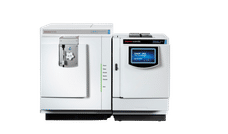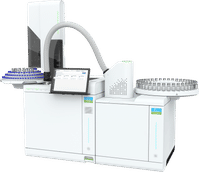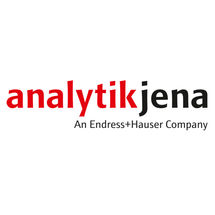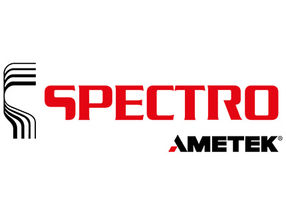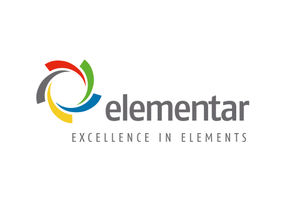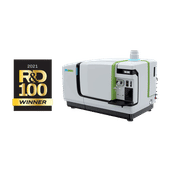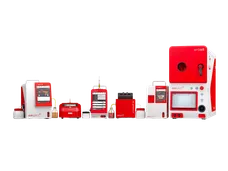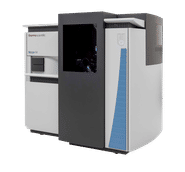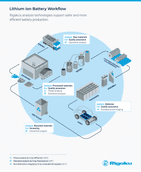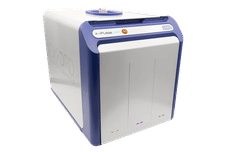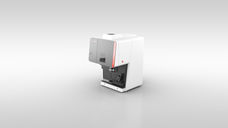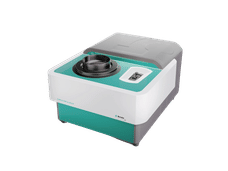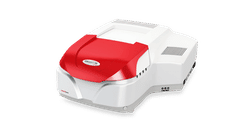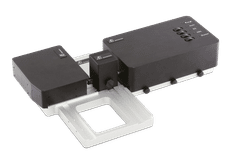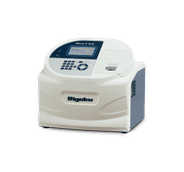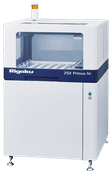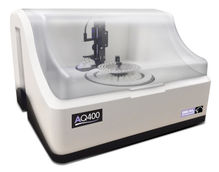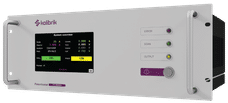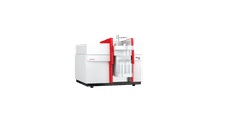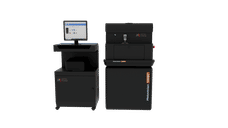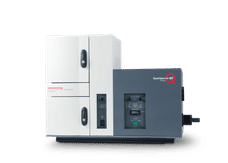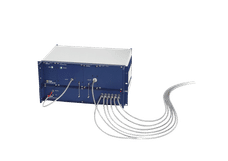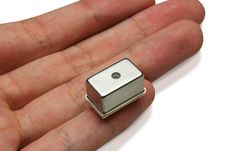Mass Spectrometers at a Glance: Products, Function and Applications
Mass spectrometers ionize the molecules in a sample and analyse their mass-to-charge ratio in order to determine the mass and structure of chemical substances. On this page you will find an overview of products from various manufacturers.
You are looking for general information about the topic? Our mass spectrometers 101 gives you all the info you need on how they work and what they're used for.
Mass Spectrometers at a Glance: Products, Function and Applications

Mass spectrometers ionize the molecules in a sample and analyse their mass-to-charge ratio in order to determine the mass and structure of chemical substances. On this page you will find an overview of products from various manufacturers.
You are looking for general information about the topic? Our mass spectrometers 101 gives you all the info you need on how they work and what they're used for.
Advertisement
Mass spectrometers at a glance
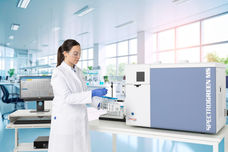 New
NewSPECTROGREEN MS by SPECTRO Analytical Instruments
Engineered to Be Better For High-Productivity Mass Spectrometry
The easy-to-use ICP-MS solution for routine analysis
Delivers exceptional analytical capacity for routine testing ✓ Superior sensitivity, stability, and ease-of-use ✓ Designed for maximum performance with minimal upkeep ✓

QGA 2.0 by Hiden Analytical
Next generation quantitative gas analysis system
Lighter, more user-friendly, environmentally considerate and packed with powerful features
Performance: rapid - can perform 1000 measurements per second. Detection from 100 ppb to 100 % ✓ Simplified Start-up: A single button manages both the pump down and software start ✓ Compact Design: Weighing less than 30 kg with a 42 % smaller footprint than the QGA ✓
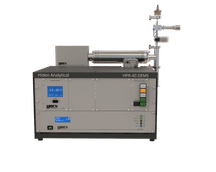
HPR-40 DEMS by Hiden Analytical
Real-Time Gas Analysis for Advanced Energy and Electrocatalytic Research
Electrochemical insights for fuel cells, batteries, CO₂ reduction, and electrocatalysts.
Versatile Mass Spectrometer system compatible with multiple cells and inlet types ✓ Deposition compatible working electrodes ✓ Rapid response ensures that gas evolution is precisely synchronized with the applied potential and ✓
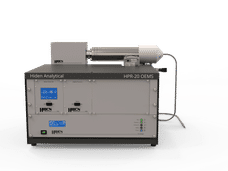
HPR-20 OEMS, Online Electrochemical Mass Spectrometer by Hiden Analytical
Online monitoring and quantification of evolved gases and vapours from electrochemical processes
A complete gas analysis solution, designed to integrate seamlessly with electrochemical applications
Capillary flow rate from 12ul/min to 16ml/min for monitoring of small cells or high flow processes ✓ Heated capillary operating at up to 200°C provides fast response times of less than < 3 seconds ✓ Software provides real time quantification of gas composition and plots E and I on the same chart ✓

PlasmaQuant MS-Serie by Analytik Jena
Mass spectrometers for highly sensitive research applications and lowest detection limits
The formula for success in LC-ICP-MS – PlasmaQuant MS series and PQ LC
Efficient, fast and accurate routine analysis ✓ Cost effective ✓ Extensive accessories ✓
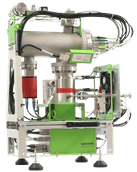
IonTamer ToF MS by Spacetek Technology
IonTamer instruments are time-of-flight residual gas analysers (TOF-RGA) for the analysis of gases
Compact Time-of-flight residual gas analyzer (TOF-RGA) for process analysis
Full quantitative chemical analysis in real-time up to ten times per second ✓ Directly integrated in-line into manufacturing process and supporting full remote control ✓ Simultaneous acquisition of full mass spectra at high resolution (masses up to 1200 u/e) ✓

isoprime precisION by Elementar Analysensysteme
isoprime precisION stable isotope ratio mass spectrometer
The most flexible, yet powerful isotope ratio mass spectrometer ever created
High performance IRMS in a compact benchtop footprint ✓ ionOS IRMS software delivers unrivalled levels of intelligent control ✓ Undertake unique research with a suite of development tools and options

GC 2400 by PerkinElmer
PerkinElmer GC 2400 Platform
The Smart behind Separations
SMART: offers remote connectivity functionality with the detachable touchscreen ✓ SIMPLIFIED: Smart sampling capabilities, status notifications and easy-to-maintain hardware ✓ SUSTAINABLE: Smart gas management helps reduce gas consumption ✓
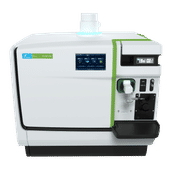
NexION 2200 by PerkinElmer
NexION 2200 ICP Mass Spectrometer
Uncompromised performance, accuracy, and repeatability
Quadrupole Ion Deflector ✓ Triple Cone Interface with patent-pending OmniRing technology ✓ free-running RF Generator with proprietary LumiCoil RF load coil ✓
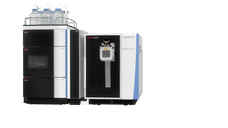
Thermo Scientific Orbitrap Exploris by Thermo Fisher Scientific
Orbitrap Exploris: Precise mass spectrometry for sophisticated analyses
High resolution and sensitivity for reliable results in biopharma and clinical applications
Market leading resolution for uncompromising data certainty ✓ Day-to-day performance consistency ✓ Out-of-the-box simplicity with a compact footprint
Choose mass spectrometers by product category
Select mass spectrometers for your application
Buy mass spectrometers for the lab or the production process
Related product categories
Find more mass spectrometers content in our topic worlds
Topic World Mass Spectrometry
Mass spectrometry enables us to detect and identify molecules and reveal their structure. Whether in chemistry, biochemistry or forensics - mass spectrometry opens up unexpected insights into the composition of our world. Immerse yourself in the fascinating world of mass spectrometry!

Topic World Mass Spectrometry
Mass spectrometry enables us to detect and identify molecules and reveal their structure. Whether in chemistry, biochemistry or forensics - mass spectrometry opens up unexpected insights into the composition of our world. Immerse yourself in the fascinating world of mass spectrometry!
Mass spectrometers 101: How they work, how they're designed, and what they're used for
Mass spectrometry is a powerful analytical method used to determine the mass and structure of molecules. By analyzing the mass-to-charge ratio (m/z) of ions in a sample, scientists can obtain precise information about the chemical composition and structure of the substances under investigation. This technique has applications in many fields, including chemistry, physics, biology, medicine, environmental analysis and forensics. In this comprehensive article, we will explain in detail the operating principle, design and different types of mass spectrometers, as well as their diverse applications and historical development.
1. What is a mass spectrometer?
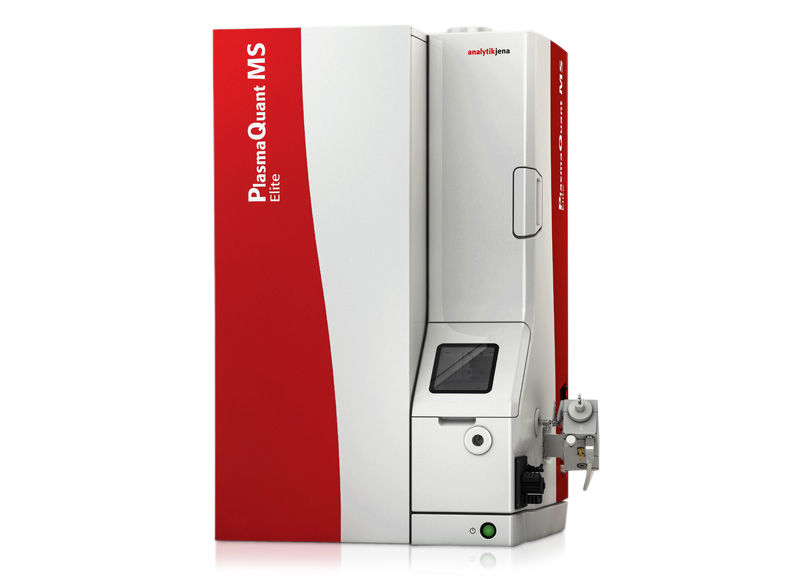
A mass spectrometer is a high-precision instrument used to identify and quantify molecules in a sample. It converts molecules into ions and sorts them based on their mass-to-charge ratio (m/z). By analyzing the resulting mass spectrum, scientists can gain valuable information about the chemical structure and composition of the sample.
The principle of mass spectrometry is based on the measurement of the mass-to-charge ratio of ions. A mass spectrum is a graphical representation of the intensity of the ions as a function of their m/z ratio. Each peak in the spectrum represents an ion with a specific m/z value, and the height of the peak indicates the relative abundance of the ion.
Mass spectrometers are essential in many scientific and industrial fields. They provide accurate and reliable results that help solve complex analytical challenges. With the ability to provide both qualitative and quantitative information, mass spectrometers are versatile and offer numerous advantages in research and practice.
2. How does a mass spectrometer work?
Mass spectrometry involves several steps: Ionization, analysis and detection.
- Ionization: The first step in the mass spectrometer is the ionization of the sample. The sample is converted into a gaseous state and ionized. There are various methods for ionization, including electron impact ionization (EI), chemical ionization (CI), electrospray ionization (ESI) and matrix-assisted laser desorption/ionization (MALDI). Each of these methods has specific applications and advantages. More on this below.
- Analysis: After ionization, the ions enter the analyzer. Here the ions are sorted based on their mass-to-charge ratio (m/z). The analyzer can be a quadrupole, time-of-flight (TOF), ion trap or sector field analyzer. Each method has specific advantages and is used for different applications.
- Detection: After the analysis, the ions reach the detector. Here the ions are recorded and their signals are converted into electrical pulses. These pulses are then converted into a mass spectrum that represents the m/z ratios of the ions. The interpretation of the mass spectrum requires expertise, as each peak in the spectrum represents an ion with a specific m/z value. The position and height of the peaks provide information about the mass and relative abundance of the corresponding ions.
3. Design and structure of a mass spectrometer
A mass spectrometer usually consists of three main components: the ion source, the analyzer and the detector.
3.1 Ion source
A mass spectrometer uses various methods to ionize the sample to produce gaseous ions. Here are four common ion sources explained in detail:
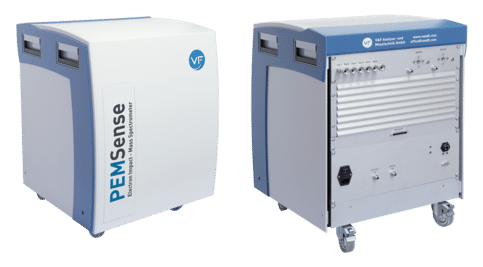
Electron impact ionization (EI)
Electron impact ionization is one of the most commonly used methods for ionization in mass spectrometry, especially for organic compounds.
- How it works: The sample is vaporized and introduced into the ion source where it encounters an electron beam. The electrons of the beam have a high energy (typically 70 eV) and collide with the molecules of the sample. This knocks electrons out of the molecules, creating positively charged ions.
- Advantages: This method produces a high number of fragment ions, allowing detailed structural analysis of the molecules.
- Disadvantages: The high energy of the electron beam can lead to extensive fragmentation, which can make it difficult to analyze large or delicate molecules.
- Applications: Ideal for small, stable organic molecules and widely used in environmental and food analysis.
Chemical Ionization (CI)
Chemical ionization is a gentler ionization method compared to electron impact ionization.
- How it works: A reactant gas (e.g. methane, ammonia) is introduced into the ion source and ionized by an electron beam. These primary ions then react with the molecules in the sample to produce positively charged ions. A typical process is proton transfer, where the reactant gas ion donates a proton to the sample molecule.
- Advantages: Since ionization occurs through chemical reactions, the fragmentation of the sample is less than with EI. This makes the method gentler and more suitable for sensitive or large molecules.
- Disadvantages: The method can produce more complicated spectra as both the reactant gas and the sample are ionized.
- Applications: Suitable for analyzing sensitive or thermally unstable compounds.
Electrospray ionization (ESI)
Electrospray ionization is a gentle method often used to ionize large biomolecules.
- How it works: The sample is placed in a solution and sprayed through a fine capillary. A strong electric field is applied to the capillary, atomizing the solution into fine droplets. These droplets evaporate and the remaining charged ions enter the gas phase.
- Advantages: ESI is particularly gentle and can ionize large, non-volatile molecules such as proteins and nucleic acids without fragmenting them. It also enables the generation of multiply charged ions (ions with more than one charge), which facilitates the analysis of large molecules at lower m/z values.
- Disadvantages: The method is sensitive to solvent and matrix effects, which can complicate spectra.
- Applications: Widely used in proteomics, metabolomics and biomolecule analysis.
Matrix-assisted laser desorption/ionization (MALDI)
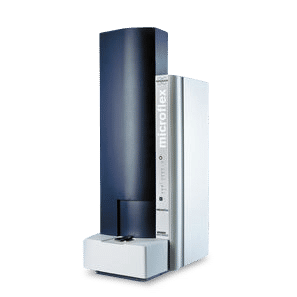
Matrix-assisted laser desorption/ionization is a method commonly used for the analysis of large biomolecules and polymers.
- How it works: The sample is mixed with a matrix (a small organic compound) and applied to a support plate. A laser beam hits the matrix, which absorbs the energy and vaporizes and ionizes the sample. The matrix protects the sample from direct laser irradiation and promotes ionization.
- Advantages: MALDI is particularly effective in ionizing large biomolecules and produces mainly singly charged ions, which simplifies the interpretation of the spectra. The method is very gentle and leads to minimal fragmentation.
- Disadvantages: The choice of matrix and sample preparation require care and can affect reproducibility.
- Applications: Ideal for analyzing proteins, peptides, polysaccharides and synthetic polymers.
These different ionization methods offer flexibility in the analysis of a wide range of samples, from small organic molecules to large biomolecules and polymers.
3.2 Analyzer
The analyzer is the second step in the mass spectrometer. Here the ions are sorted according to their m/z ratio. There are different types of analyzers:
- Quadrupole analyzer: Consists of four parallel metal rods that generate an electric field through which ions are selectively filtered based on their m/z ratio.
- Time-of-flight analyzer (TOF): Measures the time it takes for ions to fly through a field-free tube. Light ions fly faster than heavy ions.
- Ion trap mass spectrometer: Uses electric and magnetic fields to keep the ions in a defined area and analyze them.
- Sector field analyzer: Uses a magnetic field to separate the ions based on their momentum and energy.
More detailed information on how the analyzers mentioned here work can be found below in section 4 (Types of mass spectrometers).
3.3 Detector
The detectors of a mass spectrometer capture the ions coming out of the analyzer and convert their signals into electrical pulses, which are then displayed in a mass spectrum. Here are four common detectors that are explained in detail:
Photomultiplier
The photomultiplier is a sensitive detector that is used to amplify weak signals.
- How it works: When an ion hits a scintillation surface, it generates photons (flashes of light). These photons strike a photocathode in the photomultiplier, releasing electrons. These electrons are amplified by a series of dynodes, emitting more electrons at each stage, resulting in an amplification of the signal by a factor of 10^6 or more.
- Advantages: Very high sensitivity and fast response time. Can amplify very weak signals, allowing detection of low ion concentrations.
- Disadvantages: Susceptible to electrical and magnetic interference. High cost and relatively complex design.
- Applications: Widely used in trace element analysis and in applications requiring high sensitivity.
Secondary electron multiplier (SEV)
The secondary electron multiplier is a commonly used detector in mass spectrometers.
- How it works: Ions hit a first dynode, which emits secondary electrons. These electrons are accelerated to further dynodes, with each dynode releasing more electrons. This cascade effect leads to a considerable amplification of the original signal.
- Advantages: High amplification (up to 10^8), fast response times and high sensitivity. More robust and less susceptible to interference than photomultipliers.
- Disadvantages: Can be saturated by high ion concentrations, resulting in signal loss.
- Applications: Commonly used in mass spectrometry, including analysis of biomolecules, environmental samples and chemical compounds.
Faraday catcher
The Faraday catcher is a simple and robust detector that measures currents generated by ions.
- How it works: When ions strike a metal electrode, they induce an electric current proportional to the number of ions. This current is measured by a sensitive electrometer.
- Advantages: Very stable and precise. No amplification required, so the signal is directly proportional to the number of incoming ions. Suitable for quantitative measurements.
- Disadvantages: Lower sensitivity compared to photomultipliers and SEVs. Slow response times, making it difficult to analyze rapidly changing signals.
- Applications: Commonly used in isotope geochemistry and other fields requiring precise quantitative analysis.
FT-ICR and Orbitrap detectors
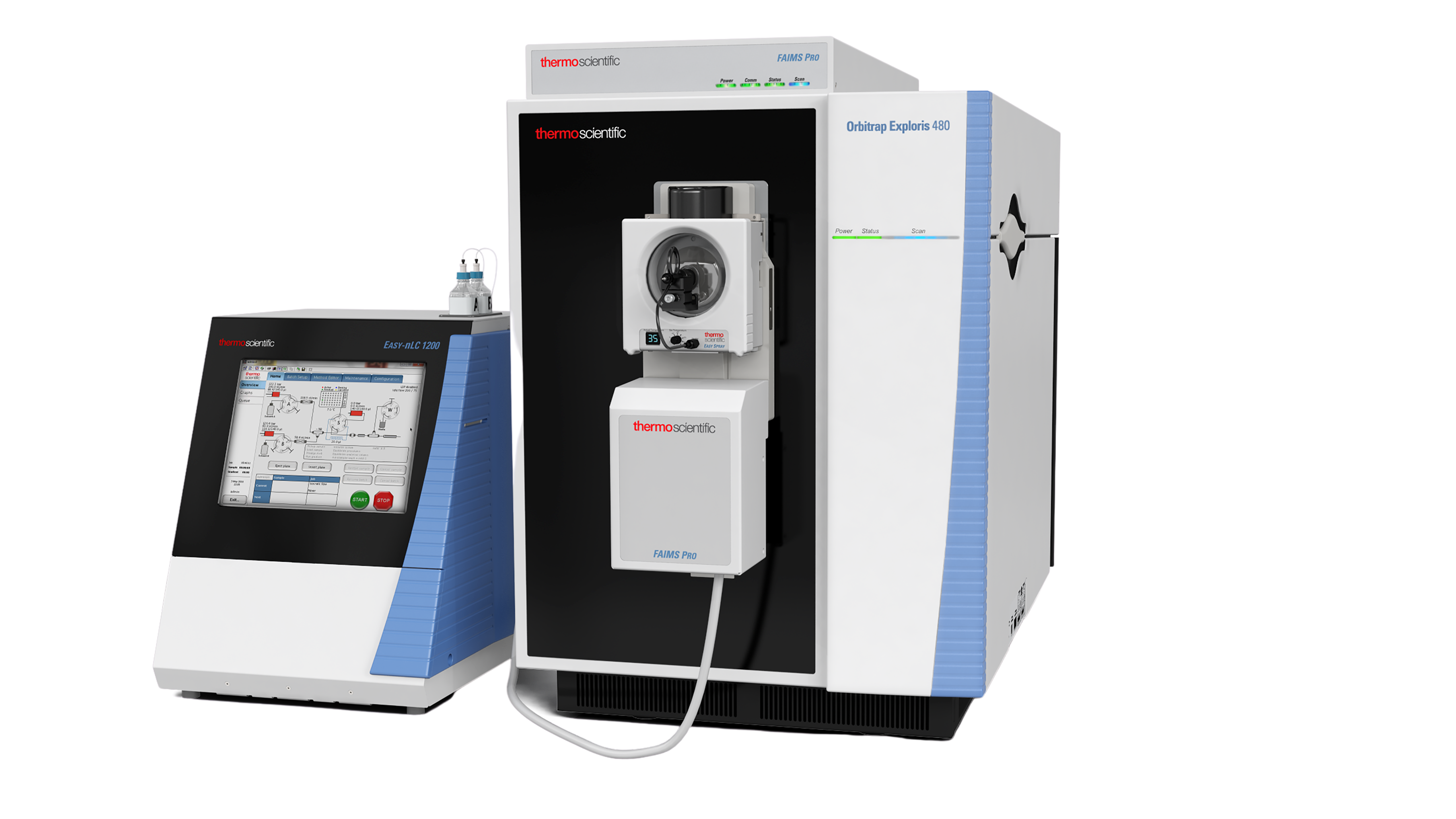
FT-ICR (Fourier Transform Ion Cyclotron Resonance) and Orbitrap detectors are sophisticated detectors used in modern mass spectrometers.
- How it works (FT-ICR): Ions are held in a cylindrical cell by a strong magnetic field and circulate in spiral paths. This cyclotronic movement induces periodic currents in the detector plates. These currents are converted into mass spectra by means of Fourier transformation.
- Mode of operation (Orbitrap): Ions are trapped in an electrostatic field and move on orbital paths around a central electrode. This movement induces currents in the detector plates, which are converted into mass spectra.
- Advantages: Very high mass resolution and accuracy. Ability to analyze complex mixtures with high precision. FT-ICR also offers high sensitivity and a large dynamic range.
- Disadvantages: High cost and complex technique. Requires strong magnetic fields (FT-ICR), which increases instrument size and operating expense.
- Applications: Use in proteomics, metabolomics, complex mixture analysis and areas requiring high mass resolution and accuracy.
These detectors offer a wide range of possibilities to capture and analyze ions coming from the different analyzers of a mass spectrometer and enable detailed and precise mass spectra for various applications.
4. Types of mass spectrometers
There are different types of mass spectrometers, which differ mainly in the analyzer used. Each type has specific advantages and applications.
Quadrupole mass spectrometer (QMS)
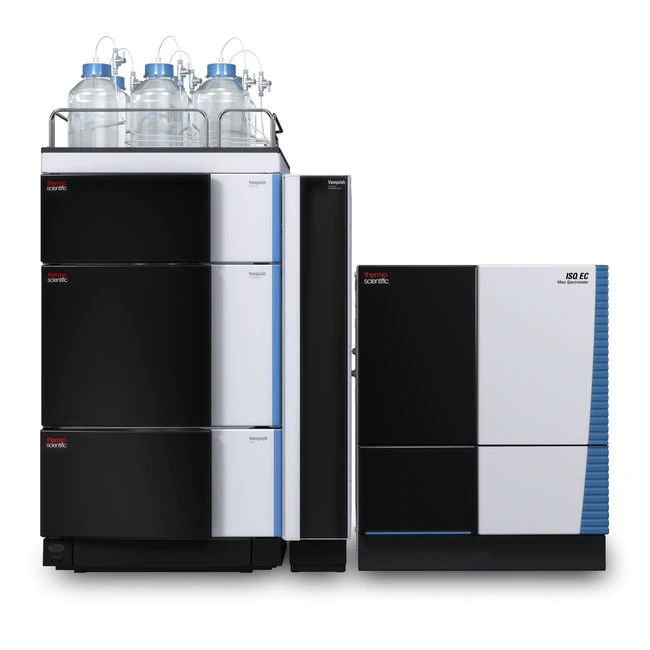
The quadrupole mass spectrometer (QMS) is one of the most commonly used mass spectrometers.
- Design and mode of operation: A QMS consists of four metal rods arranged in parallel, which generate an oscillating electric field. Ions that are passed through the electric field experience different forces that make them either stable or unstable depending on their m/z ratio. Only ions with a certain m/z ratio pass through the quadrupole filter and reach the detector.
- Advantages: QMS is compact, relatively inexpensive and offers good mass resolution and sensitivity. It allows fast scans and is very flexible in the analysis options.
- Disadvantages: Limited mass resolution compared to some other types of mass spectrometers such as TOFMS and FT-ICR.
- Applications: Commonly used in environmental analysis to monitor pollutants, in food analysis to detect contaminants and in pharmacology to determine drug metabolites.
Time-of-flight mass spectrometer (TOFMS)
The time-of-flight- or TOF mass spectrometer (TOFMS) is based on the principle of measuring the time-of-flight of ions.
- Design and mode of operation: Ions are generated in the ion source and accelerated by an electrical voltage. The accelerated ions fly through a field-free tube (drift tube) and reach the detector. Light ions reach the detector faster than heavy ions. The flight time of the ions is measured and converted into an m/z ratio.
- Advantages: TOFMS offers a very high mass resolution and an almost unlimited upper mass limit. It is particularly suitable for analyzing large biomolecules and complex samples.
- Disadvantages: Requires precise calibration and can be affected by stray field effects that can reduce resolution.
- Applications: Widely used in proteomics to analyze proteins and peptides, in metabolomics to study metabolites, and in materials science to characterize polymers and nanomaterials.
Ion trap mass spectrometer
Ion trap mass spectrometers use electric and magnetic fields to keep the ions in a defined area and analyze them.
- Design and mode of operation: There are different types of ion traps, including quadrupole ion traps (QIT), linear ion traps (LIT) and Fourier transform ion cyclotron resonance (FT-ICR) mass spectrometers. In a QIT, ions are held in a three-dimensional, quadrupolar electrostatic trap. In an LIT, ions are held in a linear quadrupolar trap. FT-ICR uses a strong magnetic field and ion cyclotron resonance to trap and analyze ions.
- Advantages: Provides high sensitivity and resolution, allows MS/MS (tandem mass spectrometry) experiments to be performed where selected ions can be fragmented and the fragments analyzed.
- Disadvantages: More complex handling and higher cost compared to simpler mass spectrometers such as QMS.
- Applications: Commonly used in proteomics for detailed analysis of proteins and their fragments, in metabolomics to study metabolic pathways and in the study of complex biological systems.
Sector field mass spectrometer
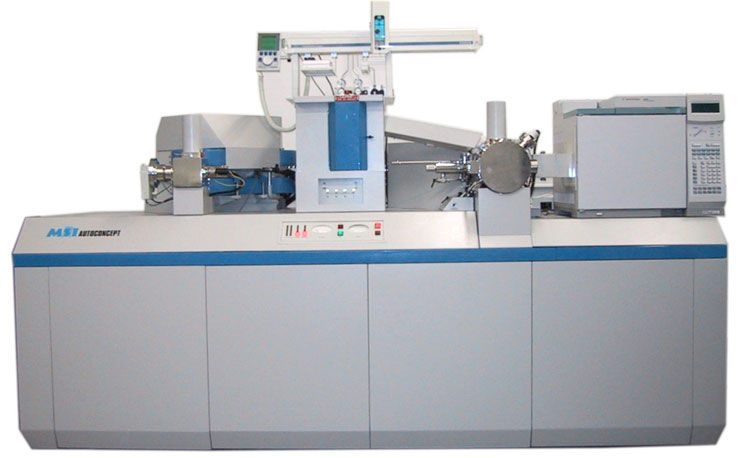
Sector field mass spectrometers use a magnetic field to separate ions based on their momentum and energy.
- Design and operation: In a sector field mass spectrometer, ions are directed by electric and/or magnetic fields. A magnetic sector field directs the ions in a circular path, where the curvature of the path depends on the m/z ratio of the ions. By varying the strength of the magnetic field, ions with different m/z ratios can be focused and separated.
- Advantages: Very high mass resolution and accuracy. Suitable for precise isotope ratio measurements and quantitative analyses.
- Disadvantages: More expensive and complex to use, larger footprint and longer analysis times compared to other types of mass spectrometers.
- Applications: Widely used in stable isotope mass spectrometry for analyzing isotope ratios, in geochemistry for dating samples and in inorganic chemistry for analyzing metal compounds.
Single particle mass spectrometer
Single particle mass spectrometers are specialized devices that are used for the analysis of particles or aerosols.
- Design and mode of operation: These mass spectrometers can analyze individual particles or aerosol droplets in real time. The particles are fed into the ion source through an aerosol injector, where they are ionized and fed into the analyser. Laser ablation is often used to ionize and analyze particles.
- Advantages: Enables real-time characterization of particle size, composition and concentration. Provides valuable information about the physical and chemical properties of individual particles.
- Disadvantages: Complex data interpretation and high cost. Requires specialized equipment and expertise.
- Applications: Commonly used in environmental analysis to monitor air quality and aerosols, in climate and atmospheric research to study particle sources and processes, and in industrial process monitoring to characterize particle emissions.
These different types of mass spectrometers offer a wide range of possibilities for analyzing a wide variety of samples, from small organic molecules to large biomolecules and particles, and are indispensable in various scientific and industrial fields.
5. Applications: What are mass spectrometers used for?
Mass spectrometry is used in many fields, including chemistry, physics, biology, medicine, environmental analysis and forensics.
Chemistry
In chemistry, mass spectrometry is used to determine chemical elements and compounds. It enables the qualitative and quantitative analysis of substances and helps to clarify the structure and composition of compounds. Qualitative analysis includes the identification of substances based on their mass-to-charge ratio (m/z), including organic and inorganic compounds, the analysis of reaction mixtures and the determination of the chemical composition of samples. Quantitative analysis is used to determine the concentration of substances in a sample and is important for analyzing impurities, quality control in production and monitoring reaction progress. In addition, structural analysis helps to determine the molecular structure and composition through fragmentation analysis, which contributes significantly to the elucidation of unknown compounds and the understanding of reaction mechanisms. Mass spectrometry is frequently used in organic chemistry, the analysis of metabolites and the characterization of polymers.
Physics
In physics, mass spectrometry is used to measure the isotopic compositions of chemical elements and to determine the masses of elementary particles and atomic nuclei. Isotope analysis makes it possible to determine the isotope ratios of elements, which is important for geochronological studies, the origin analysis of materials and environmental studies. Measuring the mass of protons, neutrons and other elementary particles contributes to research into the fundamental laws of nature and to the validation of theoretical models. Accelerator mass spectrometry (AMS) is used to detect trace isotopes such as ^14C and perform age dating, which has applications in archaeology, climate research and the study of historical artifacts.
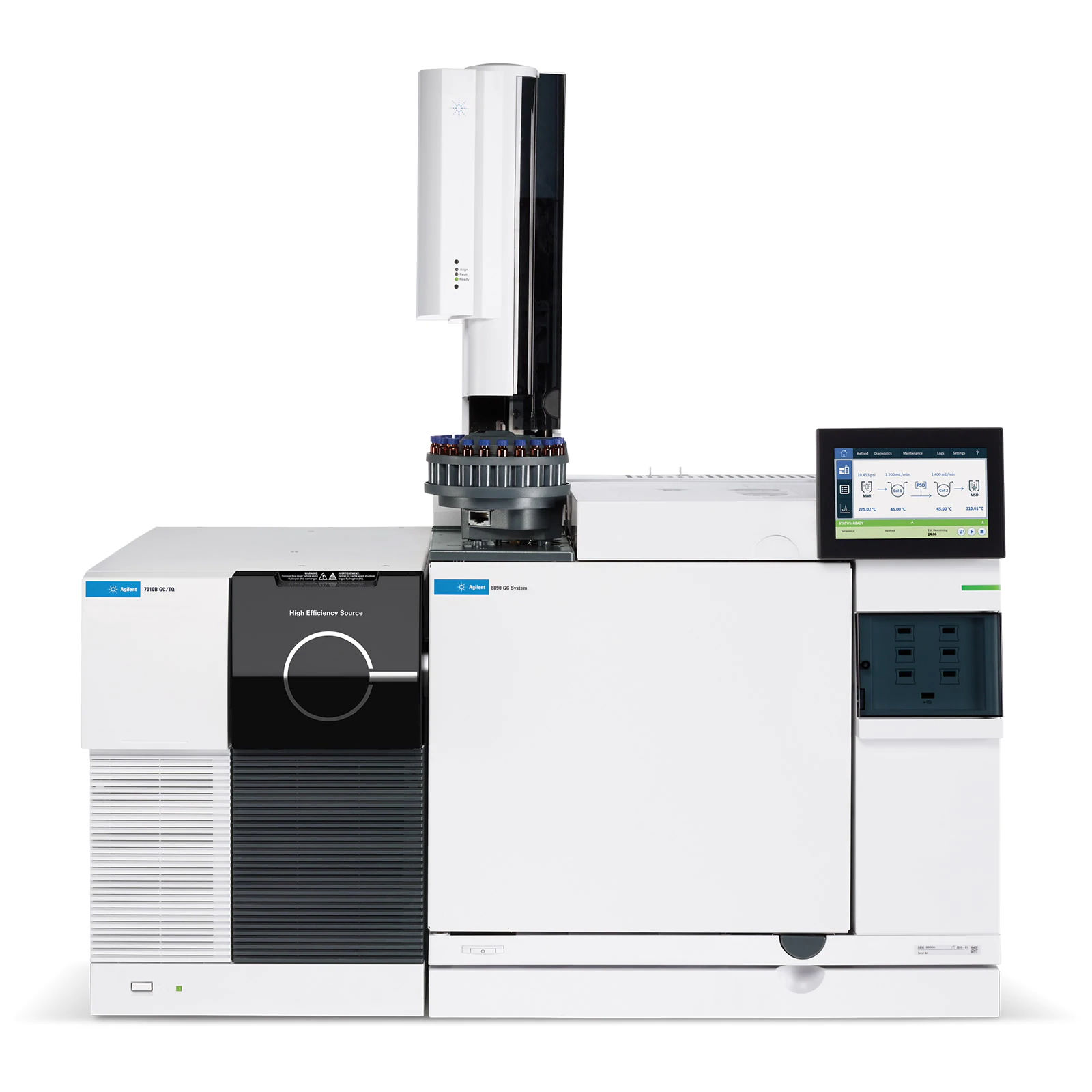
Biology
In biology, mass spectrometry is used in proteomics and metabolomics to analyze the composition and structure of proteins and metabolites. In proteomics, it is used to identify and quantify proteins, including analyzing protein expression profiles, post-translational modifications and protein-protein interactions. In metabolomics, it helps to investigate metabolite profiles in biological systems, which is important for understanding metabolic pathways, identifying biomarkers and investigating the effects of drugs. Structural analysis enables the determination of the three-dimensional structure of biomolecules and is crucial for the study of enzyme functions and the interaction between molecules. These applications are essential for disease research, drug development and the optimization of biotechnological production processes.
Medicine and pharmacy
In medicine and pharmacy, mass spectrometry is used to identify and quantify active ingredients in drugs to ensure their safety and efficacy. It is an indispensable tool in clinical diagnostics for the identification of biomarkers for diseases, supports the diagnosis and monitoring of diseases such as cancer, diabetes and cardiovascular diseases and is of great importance in forensic toxicology for the detection of drugs, poisons and other toxic substances in biological samples. It is also used in pharmacokinetics to investigate the distribution of active ingredients in the body and in drug research to develop new medicines.
Environmental analysis
In environmental analysis, mass spectrometry is used to monitor pollutants and to analyze water and soil samples. It enables the precise determination of contaminants and their concentrations, which contributes to the assessment of environmental risks and the planning of remediation measures. In water analysis, it examines water quality by determining contaminants and nutrients, which supports water supply and wastewater treatment. In soil analysis, it helps to analyze soil samples to determine pollutants and nutrient levels, which is important for agriculture and the remediation of contaminated sites. It is also used to monitor air pollutants and aerosols, helping to assess air quality and compliance with environmental regulations.
Forensics
In forensics, mass spectrometry is used to analyze samples to collect evidence in forensic investigations. It helps to identify substances such as drugs, explosives and toxins, supports law enforcement and evidence collection, and is used in forensic toxicology to analyze blood, urine and tissue samples to determine drug and alcohol levels and to investigate poisoning. Trace analysis examines microscopic samples such as hair, fibers and skin cells, which helps to identify suspects and reconstruct crime scenes. Isotope analysis can be used to determine the origin of materials and link crime scenes and suspects through isotopic fingerprints.
6. History of mass spectrometers

The development of mass spectrometry began in the early 20th century. The British physicist J.J. Thomson was one of the pioneers in this field. He developed the first mass spectrometer in 1913, which he used to investigate the isotopic composition of neon. His work laid the foundation for modern mass spectrometry.
In the 1940s, physicists Alfred Nier and John Hipple developed quadrupole mass spectrometry, which became a widely used method in analytical chemistry. In the 1950s, further advances were made in ion trap mass spectrometry and time-of-flight mass spectrometry.
The 1980s brought significant developments in ionization technology. The introduction of electrospray ionization (ESI) by John Fenn and matrix-assisted laser desorption/ionization (MALDI) by Koichi Tanaka revolutionized the analysis of large biomolecules. Both scientists were awarded the Nobel Prize in Chemistry in 2002 for their work.
In recent decades, advances in instrumentation and software have further increased the sensitivity, accuracy and range of applications of mass spectrometry. Today, mass spectrometry is an indispensable tool in many scientific and industrial fields.
7. Advantages and challenges of mass spectrometers
Advantages
Mass spectrometry offers a variety of advantages that make it an indispensable tool in many scientific and industrial applications. A key benefit is the precise identification and quantification of molecules, which provides valuable information about the chemical structure and composition of the sample. This ability to provide both qualitative and quantitative data enables the versatile use of mass spectrometry in areas such as environmental analysis, pharmacology and materials science.
Another significant advantage of mass spectrometry is its extraordinary sensitivity. It can detect extremely small amounts of substances, making it ideal for analyzing trace compounds that may not be detectable by other analytical methods. This is particularly useful in forensics and environmental monitoring, where often only small sample quantities are available.
In addition, mass spectrometry offers high resolution and accuracy, enabling the accurate determination of molecular masses and the detection of subtle differences in isotopic composition. This is particularly important in proteomics and metabolomics, where accurate characterization of molecules is critical. The ability to perform tandem mass spectrometry (MS/MS) also enables the detailed analysis of complex mixtures and the structural elucidation of molecules.
The challenges
Despite the many benefits, there are also some challenges with mass spectrometry that need to be considered. The interpretation of mass spectra requires a high level of expertise and experience. The identification and quantification of ions can be complex, especially for samples that contain many different compounds or are highly fragmented. This can lead to interpretation errors if the spectra are not analyzed correctly.
Another obstacle is sample preparation, which has a decisive influence on the quality of the results. Different samples require specific preparation and ionization methods, which are often time-consuming and technically demanding. Errors in sample preparation can lead to inaccurate results or even damage to the mass spectrometer.
The purchase and maintenance of mass spectrometers is another challenge. These devices are expensive to purchase and require regular maintenance and calibration to ensure accurate and reliable results. This means that both significant financial resources and technical expertise are required to keep the equipment running optimally. In addition, operating costs can be further increased by the need for specialized consumables and the disposal of chemical waste.
To summarize, despite its outstanding advantages, mass spectrometry also presents some challenges. Careful planning and execution of the analyses as well as a sound interpretation of the results are crucial in order to exploit the full potential of this method.
8. Conclusion
Mass spectrometry is a powerful and versatile analytical method used in many scientific and industrial fields. Its ability to provide precise information about the chemical structure and composition of samples makes mass spectrometry an indispensable tool in modern research and practice.
From chemistry and physics to biology, medicine, environmental analysis and forensics, mass spectrometry offers numerous advantages. Despite its challenges, mass spectrometry remains one of the most important methods for analyzing molecules and their properties.
9. Frequently Asked Questions (FAQ) about mass spectrometers
What is a mass spectrum?
A mass spectrum is a graphical representation of the intensity of ions as a function of their mass-to-charge ratio (m/z). Each peak in the spectrum represents an ion with a specific m/z value, and the height of the peak indicates the relative abundance of the ion. By interpreting the mass spectrum, scientists can gain valuable information about the chemical properties of the sample.
How does a mass spectrometer work?
A mass spectrometer consists of three main components: the ion source, the analyzer and the detector. The sample is ionized in the ion source, the ions are sorted in the analyzer based on their m/z ratio, and in the detector the ions are captured and their signals are converted into electrical pulses. These pulses are then converted into a mass spectrum that represents the m/z ratios of the ions.
In which areas are mass spectrometers used?
Mass spectrometry is used in many fields, including chemistry, physics, biology, medicine, environmental analysis and forensics. It is used to identify and quantify substances, to determine isotopic composition, to analyze biomolecules and to monitor pollutants.
What are the advantages of a mass spectrometer?
A mass spectrometer offers precise identification and quantification of molecules, high sensitivity, high resolution and versatility of use. It is an indispensable tool for analyzing chemical compounds and their properties.
What other types of spectrometers are there?
An overview of other popular spectrometer categories can be found here:
Haven't found the right product yet?
The chemeurope.com Product Search
Start your targeted search now with a wide selection of filter options. Here you can easily find the right product for your search, including manufacturer information and options for requesting a quote or downloading the corresponding brochure.




